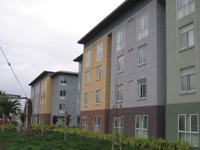In our last article, we stated that we thought the housing market slump would continue through year end and start to stabilize in early 2008. Unfortunately, there has not been any news that changes our belief. Some of the recent statistics indicate that we may still be too optimistic.
- The Commerce Department reported on December 18 that housing starts in November decreased to a seasonably adjusted 1.187 million annual rate, approximately 24% below the November 2006 estimate of 1.565 million. This was the lowest rate in 14 1/2 years as sales continue to slump and credit tightens.
- The Commerce Department reported on December 28 that sales of new single family homes decreased in November to a seasonably adjusted rate of 647,000, the lowest annual rate in twelve years. The median price decreased to $239,100, a .4% decrease from November 2006. An estimated 46,000 new homes were sold in November.
- On December 31, the National Association of Realtors reported that sales of existing homes in November were up 0.4% from October to a seasonally adjusted annual rate of 5.0 million units. Sales were 20% below the November 2006 rate of 6.25 million units. The median price was $210,200, down 3.3% from $217,300 in November 2006.
- The inventory of unsold existing homes as of November 30 was estimated to be 4.27 million, a 10.3 month’s supply at the current sales pace.(Source – Real Estate Journal)
- Unsold new homes on November 30 were estimated to be 505,000, a 9.3 month’s supply as compared to a 5.9 months supply at December 31, 2006. (Source – Real Estate Journal)
- Lenders continue to tighten requirements for mortgage lending and this has decreased the number of first time home buyers. The troubles in the subprime mortgage market and the rising number of foreclosures forced lenders to tighten their lending standards.
The multi-family section continues to enjoy another good year as the number of potential residents is increasing in part due to the tightening of lender’s requirements and the number of foreclosures. However, many of the potential renters returning to the rental market because of foreclosure may have bad credit and may not meet the qualification criteria to rent. Owners should be able to increase rents 3 – 5%. Developers should see land prices stabilizing, or maybe decreasing, as the demand for land from condo developers has cooled.
The multi-family market, like other sectors of real estate, has some common and unique terms that are used. In our last article, we discussed the terms found in the revenue section of the income statement. The following terms describe most of the major categories of expenses found on the income statement.
- Payroll – Includes the salaries and wages of property manager, leasing and maintenance personnel. Payroll taxes and employee benefits are usually included.
- Landscape – Includes plants, shrubbery, pine straw, etc. Some complexes have contracts with an outside firm while others may have an employee that does the work.
- Utilities – Includes electric, gas and water for the common area. Utilities for vacant units are normally recorded in a separate sub-account. Also included is trash removal.
- Repairs and Maintenance – Includes repairs to appliances, plumbing, parking lot, HVAC and buildings.
- Paint and Decorating (sometimes called rent ready) – painting, cleaning and carpet cleaning of vacant units in preparation to lease unit to a new resident.
- Marketing – Includes print and media advertising. A very common form of advertising is placing an ad in one of the apartment magazines.
- Management Fees – Expenses paid to a management company. The amount is usually a percentage of collections, but may be a flat amount.
- Property Taxes – Real and personal property ad-valorem taxes.
- Insurance – Includes property insurance and business liability insurance.
- Administration – Consists primarily of office expense, telephone, postage, accounting services, legal fees, credit report fees and bank charges.
The above operating expenses are usually found on an income statement that has been prepared on a cash basis. It should be noted that the replacement of items (roofs, HVAC, carpet, vinyl, appliances, etc) were not mentioned in the above categories of expenses. The replacement of these items is usually considered a capital expenditure and is not charged to expense. On certain income statements, an account called Reserve for Capital Expenditures appears. The Reserve for Capital Expenditures is an estimated amount that will be needed for replacements in the future. The net operating income – post reserve is the total income after the Reserve for Capital Expenditures. In our next article, we will discuss some of the valuation methods used to estimate a sales price.
The Macon Apartment Market has been and continues to be very active in 2007. There have been at least nine closed sales and there are at least eleven complexes currently advertised for sale.
Larry Drinkard
Commercial Real Estate Agent
Macon Commercial Office
478-746-9421



